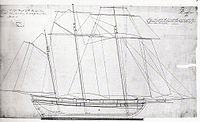
Colonial Ship King George
Encyclopedia

Ship
Since the end of the age of sail a ship has been any large buoyant marine vessel. Ships are generally distinguished from boats based on size and cargo or passenger capacity. Ships are used on lakes, seas, and rivers for a variety of activities, such as the transport of people or goods, fishing,...
, by virtue of having three masts, built in the colony of Sydney, New South Wales.
The King George was described variously as a square-rigged ship and a three-masted schooner, known in America during the later 19th century as a "tern". The confusion is due to her being modeled on the Baltimore-built three-masted schooners that had sail plans which resembled the square-rigged ships. These ships came into use in the later half of the 18th century, and would have been known to James Underwood
James Underwood
Professor Sir James Underwood is a British pathologist who was awarded a knighthood for services to medicine in the 2005 New Year honours list.-Early life and education:...
, the shipyard builder. Their distinctive sail plan feature was in having the extremely large fore and main courses, and only the fore and main topsails, with the mizzen mast rigged with the mainsail and main-topsail in place of the spanker, a plan based on the two-masted Boston pilot schooner that eventually evolved into the famed Baltimore clipper
Baltimore Clipper
Baltimore Clipper is the colloquial name for fast sailing ships built on the south-eastern seaboard of the United States of America, especially at the port of Baltimore, Maryland...
s in the 1830s. The fore and staysail booms were omitted to allow stowage of extra whaling boats and other equipment.
James Underwood undertook to build the ship with Messrs. Kable and Co. as partners and using a bond of 2,000 pounds from Simeon Lord
Simeon Lord
Simeon Lord was a pioneer merchant and a magistrate in Australia. He became a prominent trader in Sydney, buying and selling ship cargoes. Despite being an emancipist Lord was made a magistrate by Governor Lachlan Macquarie, and he became a frequent guest at government house. His business...
, a prominent colonial personality. One difficulty in securing permission to build the ship was due to the proclamation by Governor King of disallowing the building of any ship that could compete with the East India Company's trade in the Asian waters. Later Lord would try to get around the provisions by asking permission to send the King George to Fiji for sandalwood, and then to China for "a cargo".
Underwood and Kable were responsible for a number of smaller vessels and sloops, but the 188-tonne fully rigged King George would be their most ambitious construction. The keel was laid down in 1804, and she was completed with an overall length of 87 feet, a beam of 22 feet 7 inches and a 14 feet hold. Her tonnage was computed at upwards of 200 tons. This was probably her burthen as she is mentioned by other sources as having a tonnage of 180 or 185 tons, which would seem to be her displacement tonnage. Launched in April 1805 , she completed fit-out and was registered in May 1805.

Indeed her initial cruises were mostly in conducting whaling and seal trapping as The [Sydney] Gazette on 10 August 1806 recorded the arrival of "the private colonial ship King George, from a successful cruise, in which she had the good fortune to kill fifteen black whale." She spent the next several years in the southern waters, under her Master S. R. Chace, when she was spotted by the Perseverance towards the end of November in 1809 at the Aucklands after she sailed from Sydney in June 1809. During this early part of her history she is known as a whaling ship 'King George', which regularly left Port Jackson on a whale and seal hunt. However, complying with trade restrictions these were short cruises, and for example on March 2, 1810, she "arrived with skins and [whale] oil, having been at the entrance of the Bay of Islands 18 days previous."
However, soon the colonial policy was relaxed, and she was reported returning from sailing under Captain L. Jones, "from the sperm whale fishery, having procured from 30 to 35 tons of oil; out 14 months.", a cruise that would have taken her to many other ports around the Pacific Ocean.
Later in her history the King George took on cargo and general trade cruises, when she "last returned from the Bay of Islands and Marquesas, laden with sandal wood and pork, the Colonial Ship, King George, Captain Beveridge." This was one of her last cruises from Port Jackson, and the King George finished her life in Sydney as a hulk in 1820s.

